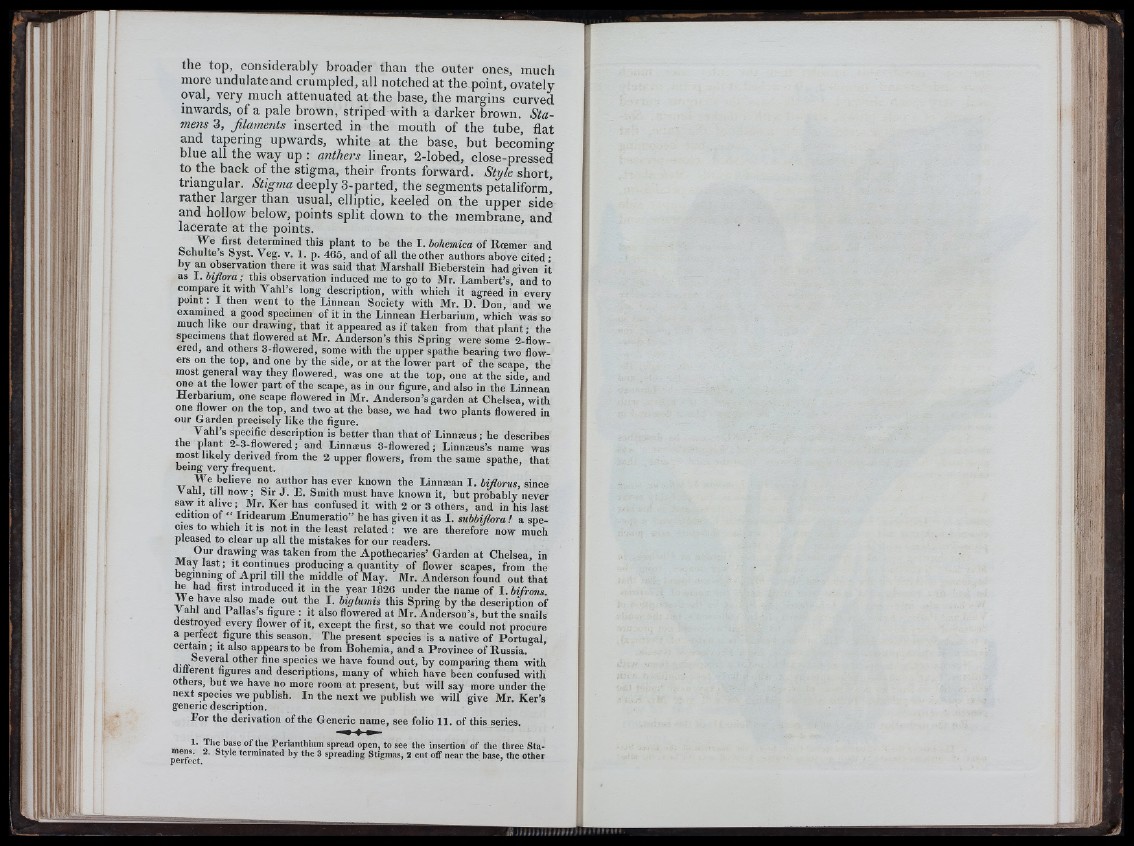
the top, considerably broader than the outer ones, much
more undulate and crumpled, all notched at the point, ovately
oval, very much attenuated at the base, the margins curved
inwards, of a pale brown, striped with a darker brown. Stamens
3, Jitaments inserted in the mouth of the tube, flat
and tapering upwards, white at the base, but becoming
blue all the way up : anthers linear, 2-lobed, close-pressed
to the back of the stigma, their fronts forward. Sty te short,
triangular. Stigma deeply 3-parted, the segments petaliform’
rather larger than usual, elliptic, keeled on the upper side
and hollow below, points split down to the membrane, and
lacerate at the points.
W e first determined this plant to be the I . i o W c a o f Roemer and
Schulte s Syst. Veg. v. 1. p. 465, and o f all the other authors above cited •
by an observation there it was said that Marshall Bieberstein had given it
as I . bijlora; this observation induced me to go to Mr. Lambert’s, and to
compare it with V ah l’s long description, with which it agreed in every
point : I then went to the Linnean Society with Mr. D . Don, and we
examined a good specimen of it in the Linnean Herbarium, which was so
much like our drawing, that it appeared as if taken from that plant ; the
specimens that flowered at Mr. Anderson’s this Spring were some 2-flowered,
and others 3-flowered, some with the upper spathe bearing two flowers
on the top, and one by the side, or at the lower part o f the scape, the
most general way they flowered, was one at the top, one at the side, and
Me at the lower part of the scape, as in our figure, and also in the Linnean
Herbarium, one scape flowered in Mr. Anderson’s garden at Chelsea, with
one flower on the top, and two at the base, we had two plants flowered in
our Garden precisely like the figure.
Vahl’s specific description is better than that of Linnæus ; he describes
the plant 2-3-flowered; and Linnæus 3-flowered; Liniiæus’s name was
most likely derived from the 2 upper flowers, from the same spathe, that
being very frequent.
xr no author has ever known the Linnæan I . ¿li/oriis, since
Vahl, till now; Sir J. L. Smith must have known it, but probably never
saw It ahve; Mr. Ker has confused it with 2 or 3 others, and in his last
edition of “ Iridearum Lnumeratio” he has given it as I . subbiflora ! a species
to which it is not in the least related : we are therefore now much
pleased to clear up all the mistakes for our readers.
Our drawing was taken from the Apothecaries’ Garden at Chelsea, in
May last ; it continues producing a quantity of flower scapes, from the
beginning of April till the middle o f May. Mr. Anderson found out that
he had first introduced it in the year 1826 under the name o f I . bifrms.
W e have ^ so made out the I . biglumis this Spring by the description of
V anl and P allas’s figure : it also flowered at Mr, Anderson’s, but the snails
destroyed every flower of it, except the first, so that we could not procure
a perfect figure this season. The present species is a native o f Portuo-al,
certain ; it also appears to be from Bohemia, and a Province of R ussia.”
species we have found out, by comparing them with
tlinerent figures and descriptions, many of which have been confused with
others, but we have no more room at present, but will say more under the
next species we publish. In the next we publish we will give Mr. Ker’s
generic description.
Lor the derivation of the Generic name, see folio 11. of this series.
1. T h e base o f the Perianthium spread open, to see the insertion o f the th ree Sta -
peHc'ct ‘erminated by the 3 spreading Stigmas, 2 cut o ff near the base, the other
rÏÎ
• ••